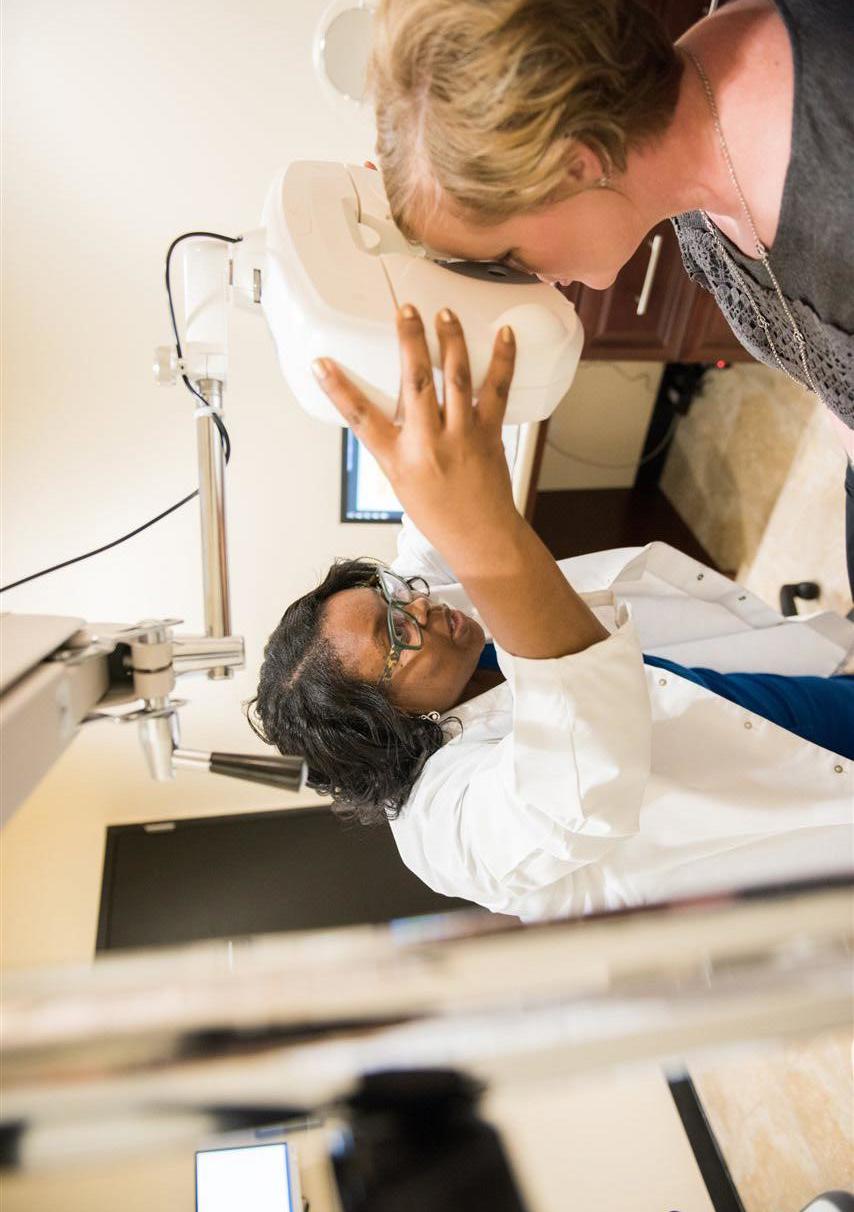R
URAL L EADER FEBRUARY 2018
M AG A Z I N E
Change is inevitable. Growth is Optional.—
GetRuralLeaderMag.com | FEBRUARY 2018 1
Contents Publisher and Editor-in-Chief Kuanita E. Murphy, PhD Rural Leader Magazine, LLC is a digital publication that highlights every day people doing extraordinary things nationally and abroad. www.RuralLeaderMag.com www.GetRuralLeaderMag.com
5 Buckle Up for the New Passenger Economy
12 From cancer nurse to cancer patient: One woman’s story
7 Here’s How the Tax Reform Plan Could Affect You
15 5 ways Businesses can Collaborate with the Education Sector to Close the Skills Gap
8 Make 2018 The Year of Helping Veterans 9 Helpful Ways to Actively Assist your Community 10 Growing your business? These 3 Financing mistakes can cost you BIG
17 First Annual Southwest Georgia Day at the Capitol 18 Growing Need for Ag Expertise: Not all High-paid Careers are on the Farm 18 How do you know if a school is right for your child?
Contact Us Rural Leader Magazine, LLC 400 West Peachtree Street Suite #4-529 Atlanta, Georgia 30308 info@ruralleadermagazine.com 1-877-281-6505 Reproduction in any manner, in whole or in part, in English, or other languages, is prohibited without written consent. Send editorial ideas to Kuanita Murphy, PhD, Editor-in-Chief editor@ruralleadermagazine.com
2 RuralLeaderMag.com | FEBRUARY 2018
Tell us what you think about our publications, if you have a great idea for a story, or to just share. We may print your comments in Rural Leader Magazine. By sending us your comments, you’re giving permission to call you for an interview. Please be sure to include your name, address, email address, and phone number so we can reach you. Write to us at info@ RuralLeaderMagazine.com—
www.GetRuralLeaderMag.com
Editor’s Note Dear Readers, Inside this issue, there are a number of great articles about leadership best practices, building positive self-esteem and productivity! We hope you enjoy this issue. As always, I hope you enjoy this issue and continue to follow us on Facebook, Twitter, Instagram, Google +, and LinkedIn. Thanks again for your continual support! Sincerely,
Kuanita E. Murphy, PhD Publisher/Editor-in-Chief
What you do matters. GetRuralLeaderMag.com | FEBRUARY 2018 3 @RuralLeaderMag
4 RuralLeaderMag.com | FEBRUARY 2018
Buckle Up for the New Passenger Economy A hundred years ago, few thought that the clunky automobile that broke down so often would ever replace a horse. In the 1970s, people wondered if the personal computer that a few eccentrics were using would have any use beyond storing recipes. It’s safe to say that these innovations, along with many of the technologies we now use daily, were once considered impossible dreams. Right now, the most-talked-about piece of technological innovation that is poised to transform our lives is the autonomous or self-driving car. As self-driving cars gain widespread adoption, analysts are predicting the rise of what is known as the passenger economy - a term coined by Intel - that is expected to be worth $7 trillion by 2050 as validated in a new report by analyst firm Strategy Analytics. Seven trillion dollars is a lot of money! A decade ago, people couldn’t fully imagine the way smartphones would give rise to the app economy. Today we are at the threshold of something equally momentous - that’s why entrepreneurs and investors are now beginning to imagine the economic possibilities tied in with autonomous cars. The following are five big areas of opportunity that will unfold in the passenger economy era. Time will be on people’s side. One of the most obvious benefits of a self-driving car is the amount of time it frees up. Drivers become passengers, and so will be able to concentrate on other tasks. Not only will people be able to work or watch a movie on their way to work, but the commute itself will be shorter, since traffic congestion will become a thing of the past. With smarter analytics, it’s estimated that by 2050, the widespread use of autonomous cars will free up over 250 million hours of commute time per year in the most congested cities.Apps were only the beginning. As more people use autonomous cars, companies and entrepreneurs will respond by developing innovative applications that will entertain and provide services to passengers. Just like innovators
used smartphones to unlock the sharing economy, there will be opportunities for startups to discover new “car-veniences” that will be expected to generate some $200 billion in revenue.A new world of advertising. From the late ‘90s, we started seeing new forms of advertising emerge on the web. With self-driving cars, we are poised to see powerful new opportunities that deliver personalized messages to consumers. For instance, algorithms can compute routes and route history to hone in on passengers with specific onboard advertisements from surrounding businesses or attractions. This could be a huge boost to local businesses and will be much more effective than the primitive billboard.Mobility-as-a-service. Imagine ordering take-out, or having your groceries or a package of diapers come to your door via a driverless car. This is something that we’re likely to see fairly soon. Shipping and freight companies, local delivery services and internet giants will make use of autonomous vehicles to transport goods across the country. These types of services will likely generate $3 trillion in revenues by 2050. New business models. Today, many companies offer perks such as work-from-home days or the option for people to leave the office to work in a cafe or wherever is most suitable for them. In the not-too-distant future, the workplace will further transform as the commute evolves. The self-driving car will blend with the office, turning the commute into a productive part of the workday. In turn, this will allow people to go home earlier and spend more time with their families.The advent of the passenger economy will contribute to a safer and more efficient world. Those who can imagine and anticipate the coming changes will be in the best position to get the most out of it.—
GetRuralLeaderMag.com | FEBRUARY 2018 5
6 RuralLeaderMag.com | FEBRUARY 2018
Here’s How the
Tax Reform Plan Could Affect You
With the newly passed tax reform bill, the Tax Cuts and Jobs Act (TCJA), now is the time to start thinking about how this will affect you so that you can plan ahead for the outcomes you will start to feel in your paycheck as early as February 2018. This tax reform affects virtually everyone; however, families, homeowners, residents of high-tax states, the medically uninsured and small businesses will be especially affected. Most taxpayers will experience changes that could reduce or increase their taxes owed. If you’re not sure how this may affect you, here is a summary of possibilities. Families Like most taxpayers, many families will be affected by the loss of personal and dependent exemptions of $4,050 per person. However, families with income under $200,000 ($400,000 for joint filers) will be eligible for an increased child tax credit of $2,000. Those with income over that amount may be eligible for a smaller credit. This, along with larger standard deductions, may or may not make up for the loss of the personal exemption. Families with dependents over the age of 16 may also qualify for a new family tax credit of $500 for each dependent who does not qualify for the child tax credit. Homeowners and residents of high-tax states Homeowners and residents of high-tax states like California, New York and New Jersey, who typically itemize because they have large expenses like real estate taxes and state and local income taxes, may not be able to get the full tax benefit for these expenses, which are capped at $10,000. Some may not find it worthwhile to itemize going forward. Itemizing deductions is only worthwhile if all expenses exceed the standard deduction. Medically uninsured Starting in 2019, there will no longer be a penalty for those without health insurance. The penalty, which had become more and more expensive since first implemented in 2014, will not apply to taxpayers
without insurance in 2019. Taxpayers who did not have insurance for all of 2017 and do not expect to be insured in 2018 need to make sure to talk to a tax professional, who can help you identify if you qualify for a penalty exemption. Small-business owners Some of the largest changes in the tax reform legislation apply to businesses, both large and small. These changes may also affect some rental activities. Corporations will see their top tax rate reduced to 21 percent from the current top rate of 35 percent, starting in 2018. Pass-through entities (LLCs, partnerships and S corporations) and self-employed individuals will be able to deduct 20 percent of their business income, subject to some limits (based on the type of business and income) and phase-outs (based on the partner’s/shareholder’s total income). Retirement Under the current law, taxpayers can reconvert a Roth IRA into a traditional IRA. This allows taxpayers to avoid paying high tax bills on an amount of money that had fallen in value after the conversion. Now, taxpayers will no longer be able to reconvert a Roth IRA to a traditional IRA. The bottom line is that with this new tax legislation, you’re still going to need to get your documents in order and file your taxes, as well as decide if you’re going to itemize and what deductions work for your personal situation. This year, it’s more important than ever to talk to a tax professional about how this affects you to ensure that your taxes are done right and that you have a clear understanding of how changes that take effect in 2018 will impact how you file in 2019. To learn more about the tax reform, how it may affect you and what steps you can begin taking to reduce what you owe in 2018, visit www.hrblock.com or make an appointment with a tax professional.—
GetRuralLeaderMag.com | FEBRUARY 2018 7
Make 2018 The Year of Helping Veterans For many of us, the new year is the perfect time to make resolutions that improve our own lives. What if, this year, your resolutions included giving back to a community that has sacrificed so much for not only you, but our country? According to the most recent U.S. Census, there are 18.8 million veterans in the U.S. Today, more than 9 million are seeking treatment at their local U.S. Department of Veteran Affairs medical center, and more than 39,000 veterans are homeless on any given night, according to the U.S. Department of Housing and Urban Development. Now more than ever, consider lending a hand to those who have selflessly defended our freedom and need our help. There are many ways to help a veteran in need. Below are a few suggestions on how you can make a difference in a veteran’s life this year. Reach out to a veterans service organization to learnmore. Knowing where to begin can seem daunting, but you don’t have to figure it out alone. The American Legion Auxiliary (ALA), The American Legion and Sons of The American Legion are three organizations actively involved in veteran causes with local units across the U.S. They offer community through memberships, organize and hold volunteer events throughout the year and accept monetary donations. As a first step, visit the websites of each organization and look for a unit close to you. Meeting with these organizations or others can kick-start your efforts to get involved with the veteran community. 8 RuralLeaderMag.com | FEBRUARY 2018
Tie your passion to your action. We all have passions that bring us joy. There are many ways that suit your interests to give back while helping veterans in need. For example, do you like to spend time outdoors? A large number of organizations host volunteer activities like cleaning a veterans memorial in the community. Are you more of a people person? Give your time to a local veterans facility to connect with a resident in need of company. Donate a day of service. Everyday life can get messy with full-time jobs and commitments. One way to identify free time for charitable activities is to use a day off engaging in community service. “Donate” your Memorial Day to help the ALA distribute handmade poppies that support veterans in local hospitals, visit a veterans facility or deliver a meal or care package. Give a gift during the giving season. sThe holiday season is a time to reflect on what you have and to appreciate the loved ones in your life. This year, extend your thankfulness to the veteran community. On Nov. 27, participate in #GivingTuesday, the global giving movement. Make a monetary donation to an organization that dedicates its efforts to helping veterans. Whether you come together as a family, a company, a community or by yourself, a donation can make a real difference. MHelping a veteran can be a year-long commitment or a one-day activity. To learn more about how to take the first step, visit www.ALAforVeterans.org.—
GetRuralLeaderMag.com | FEBRUARY 2018 9
Dr. Nacondus Gamble, owner of The South Eastern Eye Center, an optometry practice in Georgia, found a business loan through Funding Circle.
Growing your business? These 3 Financing mistakes can cost you
BIG
Starting a business can be tough. Growing one can be even harder. Dr. Nacondus Gamble knows this all too well. After her optometry practice, The South Eastern Eye Center, began to establish a reputation for great patient care, Dr. Gamble decided she was ready to expand. So she began looking for business financing to open another location in Georgia. That’s when she discovered that many lenders don’t share her commitment to high-quality service. “I called a couple of places, but I just felt like they were taking advantage of me,” she said. “It was unnecessarily harsh.” Dr. Gamble ended up borrowing through Funding Circle, an online platform focused exclusively on small business loans. Known for its speed, transparency and customer service, Funding Circle has helped more than 40,000 businesses around the world get financing, says co-founder and U.S. managing director Sam Hodges. Today there are more options than ever before for businesses looking to grow. While some of these newer options can offer a significant leg up, others can actually end up doing more harm than good. So how can you get the best deal on a business loan? It helps to watch out for these three common mistakes: 1. Not understanding the true cost of your loan When shopping for a business loan, it’s easy to become overwhelmed by fast-talking salespeople, endless strings of acronyms and confusing terms. If it’s unclear how much you’ll really pay for financing, that’s a good sign you should walk away, Hodges cautions. A good lender will always be willing to help you calculate the Annual Percentage Rate (APR) and explain all the terms of your loan clearly. They’ll also help you understand what fees you can expect over the life of the loan - some lenders sneak in additional hidden fees, concealing them in fine print or confusing legalese, which can significantly inflate the cost. 2. Getting trapped in daily or weekly repayment cycles 10 RuralLeaderMag.com | FEBRUARY 2018
Some types of business financing can seem like a godsend for a company in need of fast cash. These providers promise easy approval with quick access to funds. However, that speed can come at a steep price - in many cases, the provider takes a portion of your sales on a daily or weekly basis until the debt is repaid. Term loans are often the better option, Hodges says. They allow businesses to borrow a set amount of money for a specific purpose, like hiring new staff or stocking up on inventory. The funds are then paid back over a set amount of time, with consistent monthly payments and no surprise fees. 3. Not knowing what you deserve While many finance providers have your best interests at heart, the truth is that not all do. Some use irresponsible or misleading practices and take advantage of small business owners’ need for cash. After seeing countless small businesses get stuck with credit products they couldn’t afford or understand, a coalition of small business advocates, lenders and online credit marketplaces came together to launch the Small Business Borrowers’ Bill of Rights. As the first-ever gold standard for responsible business lending, the Bill of Rights outlines the rights and safeguards that small businesses should expect from finance providers. These include the right to transparent pricing and terms - ensuring business owners can see the cost and terms of any financing being offered in writing and in a form that is clear, complete and easy to compare with other options - and the right to non-abusive products that won’t trap you in an expensive cycle of re-borrowing. Before you take out any financing, check if your lender has signed on at ResponsibleBusinessLending.org. Considering a loan for your business? You should know the five things business lenders typically care about when evaluating your application. To maximize your success, read more at www.Made2DoMore.com.—
GetRuralLeaderMag.com | FEBRUARY 2018 11
Lindsay Norris, her husband, Camden, and their two children.
From cancer nurse to cancer patient: One woman’s story Throughout her career, Lindsay Norris had a close connection with cancer, helping others battle the disease. Then one day, it became even more personal. The 33Â-year-Âold oncology nurse still remembers the moment she heard the news of her own diagnosis - Stage 3 colorectal cancer. “I’ve been in those conversations so many times,” she said. “I’ve shared a plan of care so many times. I’ve explained this stuff so many times.” Lindsay knew the cancer journey but now she was the one on the receiving end of the conversation. Living with cancer While the magnitude of a cancer diagnosis cannot be denied, a Pfizer-sponsored survey of over 1,500 cancer patients and caregivers to assess resources, tools and general perceptions of cancer shows nearly 85 percent of the patients surveyed have a positive outlook on cancer and 83 percent have been inspired to make positive changes in their life following their diagnosis. In fact, nearly 90 percent of patients surveyed believe cancer has forced them to prioritize important things in their life and 3 in 5 patients surveyed said cancer allowed them to discover the “real me.” That said, day-to-day life with cancer is challenging and the same survey shows a majority of those patients and caregivers surveyed say it would be helpful to have an all-in-one mobile tool or app while managing life with cancer, stating some of the most helpful resources would be the ability to keep track of questions that come up during the day (77 percent) and during medical appointments (76 percent), keeping track of medications (71 percent) and being able to communicate with loved ones (71 percent). Pfizer recently launched LivingWith(TM), a free mobile app to help patients and their loved ones manage life with cancer and organize certain important information in one place, which may help to address some of these tasks and communication challenges. While Lindsay has adjusted some things in her life since her diagnosis, her commitment to her work as a nurse has remained steadfast and each day she comes to the hospital as both patient and professional. “I figured I have to come every day for treatment anyway, so I might as well work,” she said of juggling care for her patients with her own treatment schedule. “I’ve always taken pride in my job and taking care of my patients. I have always tried to put others before myself.” Of course, like most people with cancer, Lind12 RuralLeaderMag.com | FEBRUARY 2018
say, a mother of two young children, has her good days and her bad days. On her good days she can go without taking a nap and is able to make dinner for the family and enjoy bath time. But on her bad days, she simply can’t enjoy these activities and that’s when her husband steps in to help. The missed opportunities sadden her, but she understands these struggles are part of living with cancer and refuses to let them define her. She still remembers breaking the news of her diagnosis to her family and her 3Â-year-Âold son Harrison referring to the disease as mom’s “cancer owie.” He said to me, “Mom, after your cancer owies are all gone and you’re done taking your special medicine, you can have a sleepover in my boysÂ-only fort.” Lindsay keeps this goal in mind, and while her battle with cancer is far from over, she’ll have her sleepover in that fort. Chronicling a patient’s story Lindsay’s story is one of several featured now on ThisIsLivingWithCancer.com, a novel program sponsored by Pfizer that allows people to share inspiring stories and follow along on Facebook and Instagram to receive and share daily stories of inspiration. Lindsay is extremely proud to be part of the campaign and is hoping the LivingWith(TM) app and her story connects with others. “I want to make it a positive experience. And hopefully when my son is an adult he’ll look back and be proud of the way his mom handled it. The best piece of advice I received is to ‘do everything you can today, and then do everything you can tomorrow.’” Lindsay and others involved in the campaign are interested in the possibilities of the LivingWith app, particularly how it may give patients and caregivers a sense of control when it comes to managing the many aspects of life with cancer such as building a network of support from friends and family to get help with daily tasks, recording and remembering important information from doctor visits and finding information about local events and nutrition articles. It even provides a section to track those “cancer-owies” that Lindsay’s son noted, to help people provide an accurate assessment during their doctor visits. Join Lindsay and others affected by cancer who have downloaded LivingWith(TM) from the Apple App store or Google Play and visit ThisIsLivingWithCancer.com to help you or a loved one manage life with cancer.—
GetRuralLeaderMag.com | FEBRUARY 2018 13
14 RuralLeaderMag.com | FEBRUARY 2018
5 ways Businesses can Collaborate with the Education Sector to Close the Skills Gap With U.S. graduation rates being at an all-time high, one might expect employers to have a wealth of qualified candidates to hire. Instead, many employers are finding that these recent graduates are unprepared to succeed in the workforce. While many are graduating with technical skills, their “soft skills” are lacking. These skills - from professional communication and critical thinking to collaboration and time management - are seen as critical by employers, yet have not historically been taught with consistency or prioritized. A recent whitepaper commissioned by the U.S. Chamber of Commerce Foundation and AVID (Advancement Via Individual Determination), an education nonprofit that equips students with the necessary soft skills needed to be successful in college and their careers, highlights recent partnerships between the business and education sectors to tackle this skills gap. “Bridging the Soft Skills Gap: How Employers Can Partner with Educators to Prepare Students for the 21st Century Workforce” offers practical recommendations for businesses to make an impact and profiles strategic partnerships being successfully implemented across the country by Nike, Ernst & Young, Wegmans, Wynn Las Vegas, and the Northern Kentucky Education Council. According to a 2016 analysis by the Wall Street Journal, 92 percent of nearly 900 surveyed executives said soft skills were as or more important than technical skills, yet 89 percent reported some level of difficulty finding employees who have mastered these skills. “With almost 6 million unfilled jobs in America, this lack of soft skills hurts workers, businesses and the economy,” says Cheryl Oldham of the U.S. Chamber of Commerce Foundation’s Center for Education and Workforce. “Businesses recognize the critical need for soft skills and are working hard in their communities to help students obtain the skills they need to succeed in the jobs of tomorrow.” A growing number of companies are focusing on student education as a part of their business strategy. By equipping students with the skills for workplace success, they strengthen their talent pipeline and create shared value. The following insights from the
whitepaper offers successful approaches to collaboration between the education and business sectors to help youth become better prepared for their careers. Classroom solutions Investing in classroom solutions empowers teachers to better help young people develop the skills they need in school, work, and life. Since promoting soft skills is less about what is taught than how they are taught, access to hands-on methodology training for educators is vital. Employers can help by ensuring that teachers and administrators across local schools have access to proven professional development programs from established education nonprofits. Mentoring for college and career readiness Businesses can mobilize employees to mentor students based upon a college and career readiness curriculum. Proponents of these mentoring programs say that they enhance employee satisfaction and retention; strengthen the talent pipeline; and contribute to thriving communities. Adopt-a-school In adopting a specific school or school district, businesses typically identify and commit to meeting a holistic set of needs through multifaceted programming, ranging from tutoring and mentoring to specific grants for programming and facilities. Work-based learning Instead of solely offering traditional internships for college students, businesses can partner with high schools to establish pre-employment apprenticeship programs designed to introduce students to workplace demands. The Department of Labor supports employers that establish Registered Apprenticeships to build a robust talent pipeline. Coalition building Building a coalition of representatives from industry, the education system, and the community creates the space for meaningful dialogue about common priorities and unique local challenges. It also facilitates collective action around solutions. MFor more on how the business and education sectors are closing the skills gap, click here to read “Bridging the Soft Skills Gap: How Employers Can Partner with Educators to Prepare Students for the 21st Century Workforce.”— GetRuralLeaderMag.com | FEBRUARY 2018 15
16 RuralLeaderMag.com | FEBRUARY 2018
The First Annual Southwest Georgia Day at the Capitol January 11. The theme slogan for the day was “Showing the Rest of Georgia, the Best of Georgia.” The event was made possible by Senator Freddie Powell Sims, Representative Gerald Greene, Audrey Murphy Lee, and Michelle McKelly. Various businesses and organizations throughout South Georgia were invited to showcase their products and services. Albany Technical College, Andrew College, One Sumter County, Omaha Brewing, ShaLo's Event Center, Job Pro Services, Rollin Smoke, and Rural Leader Magazine participated. Rural Leader Magazine’s 2017 Forty under Forty Class was also recognized during the event with Senate Resolution number 581 by Senator Freddie Powell Sims. #
GetRuralLeaderMag.com | FEBRUARY 2018 17
How do you know if a school is right for your child? Public, private, charter, virtual and more - deciding what school is best for your children can feel overwhelming. You want them to have an education that prepares them for a challenging world while fitting their unique learning styles. How do you know the best option to ensure they thrive? “The right school will not only help your child learn essential skills but instill a lifelong love of learning,” says Carol Lloyd, award-winning educational writer and editorial director for GreatSchools, a nonprofit school guide. “Bottom line: The school you choose for your child does make a difference.” Lloyd knows making educational decisions isn’t easy. That’s why she offers her advice on the most important things to consider when researching schools. Testing scores: How does the school perform on state assessments across grades and subjects? Look at the percentage of students who score at or above proficiency. If possible, look at test scores by student subgroup (race/ethnicity and family income). How are students like your child doing? Student progress: Test scores don’t tell the whole story. It’s important that no matter where students start on the educational spectrum, they make progress and continuously learn as time passes. Understanding student progress can give you important information about how much children are learning at this school from year to year. Equity: Look at how students from all backgrounds are doing. Is there a big achievement gap between different groups? This helps you understand how schools are serving disadvantaged student groups. 18 RuralLeaderMag.com | FEBRUARY 2018
Advanced coursework: To understand the academic rigor of a school, research the advanced courses offered. How many students are enrolling in those courses? What’s the average number of advanced courses a student takes at the school? All these details can paint a picture about whether the students are getting the classes they need for college and beyond. Discipline and attendance flags: Does the school have high chronic absenteeism? Do they suspend some groups of students far more often than others? This might be a red flag that you should consider. College readiness: If you have a high school student, you’re probably starting to think about the future. If you want to ensure your child’s school is preparing them for college, research the high school’s SAT/ACT participation and performance. To check out schools in your area and learn more about school ratings and data, visit www.greatschools.org. You can quickly view this information and easily compare it against other schools you’re considering, helping you save time while providing you the necessary information to make a confident decision about your child’s education. “The updated school profiles on GreatSchools display information parents need, and provide support to help them take action,” says Lloyd. “For example, if a school has a low Equity Rating compared to other schools in their state, parents will find tips on how to discuss improving the education of all students at this school with teachers and administrators. This empowers parents today and in the future so their children can receive the education they deserve.”—
GetRuralLeaderMag.com | FEBRUARY 2018 19
20 RuralLeaderMag.com | FEBRUARY 2018






